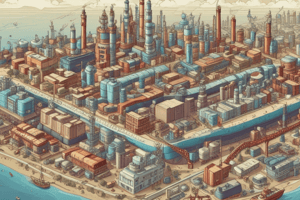Podcast
Questions and Answers
Which of the following best describes a primary industry?
Which of the following best describes a primary industry?
- Involves the extraction and production of raw materials (correct)
- Provides services rather than goods
- Focuses on manufacturing finished products
- Engages in research and information technology
What characterizes a large-scale industry?
What characterizes a large-scale industry?
- Limited capital and labor-intensive operations
- Operates primarily within national borders
- Is mainly owned by cooperatives
- Significant capital investment and advanced technology (correct)
In the context of industry classification, what is a distinguishing feature of light industries?
In the context of industry classification, what is a distinguishing feature of light industries?
- Involvement in the extraction of raw materials
- High capital requirements and large-scale production
- Focus on research and development activities
- Lower capital requirements and labor intensity (correct)
Which type of industry is primarily responsible for the manufacturing of consumer goods?
Which type of industry is primarily responsible for the manufacturing of consumer goods?
What distinguishes durable goods from non-durable goods?
What distinguishes durable goods from non-durable goods?
What key technological advancements characterize Industry 4.0?
What key technological advancements characterize Industry 4.0?
What was a significant impact of Industry 2.0 on operations management?
What was a significant impact of Industry 2.0 on operations management?
How is the concept of a system defined in the context of organizational operations?
How is the concept of a system defined in the context of organizational operations?
What production characteristic distinguishes construction from manufacturing?
What production characteristic distinguishes construction from manufacturing?
Which of the following best describes the impact of automation in Industry 3.0?
Which of the following best describes the impact of automation in Industry 3.0?
Flashcards are hidden until you start studying
Study Notes
Industry Overview
- Industry encompasses all economic activities related to producing goods and services in specific fields.
- It includes various sectors like agriculture, automotive, aviation, construction, energy, food and beverage, manufacturing, mining, telecommunications, aerospace, textile and apparel, and education.
Types of Industry
- Primary Industry: Extracts and produces raw materials.
- Secondary Industry: Manufacturing and construction focus.
- Tertiary Industry: Offers services instead of goods.
- Quaternary Industry: Centers on information technology and research.
Economic Classification
- Raw-Material Based: Industries classified by the type of raw materials used, including agro-based, mineral-based, marine-based, and forest-based.
- Size: Classifies into small-scale (labor-intensive) and large-scale (capital-intensive).
- Ownership Structure: Private (individually owned), public (government-owned), joint sector (public and private), and cooperative (managed by suppliers or workers).
- Heavy vs. Light: Heavy industries involve significant capital and large-scale production; light industries are labor-intensive.
- Domestic vs. Foreign: Domestic industries operate within national borders; foreign industries originate outside the country.
- Durable vs. Non-Durable: Durable goods have a longer lifespan; non-durable goods are consumed quickly.
- Manufacturing vs. Construction: Manufacturing produces final goods, while construction focuses on intermediate goods and components.
Evolution of Industry
- Industry 1.0 – Mechanization: Introduced steam engines and centralized production; transformed manufacturing processes, beginning with textiles.
- Industry 2.0 – Mass Production: Brought electricity and assembly lines; Henry Ford revolutionized production techniques.
- Industry 3.0 – Automation: Focused on electronics, IT, and robotics; enhanced efficiency and embraced lean manufacturing.
- Industry 4.0 – Digital Transformation: Integrated cyber-physical systems, IoT, AI, and big data; emphasized real-time decision-making and customization.
Operating System Defined
- An operating system in an organization produces physical goods and services.
- Systems are collections of integrated parts aimed at achieving a specific goal.
Key Elements of a System
- Components: Individual parts making up the system.
- Processes: Interactions among parts to achieve goals.
- Inputs: Resources necessary to initiate the system.
- Outputs: Results or products generated by the system.
- Goals: Objectives the system aims to accomplish.
Concepts of Operation
- Manufacturing Operations: Involve tangible outputs.
- Service Operations: Provide intangible outputs.
Components of an Operating System
- Inputs: Expertise, funding, equipment, customer feedback, and strategic priorities.
- Processes: Include planning, designing, production, and quality control.
- Outputs: High-quality products or services.
- Outcomes: Customer satisfaction which influences the system.
Types of Operation Systems
- Classification by Product Flow:
- Flow Shop: Resources arranged in accordance with production sequence.
- Job Shop: Products follow variable paths based on job specifications.
- Project Production: Resources are brought to the production site; the product remains stationary.
- Classification by Output: Outputs may be tangible (products) or intangible (services).
- Specification of Output:
- Standardized products are uniform and produced at scale.
- Custom products are tailored to specific customer needs.
Studying That Suits You
Use AI to generate personalized quizzes and flashcards to suit your learning preferences.




